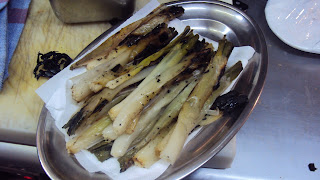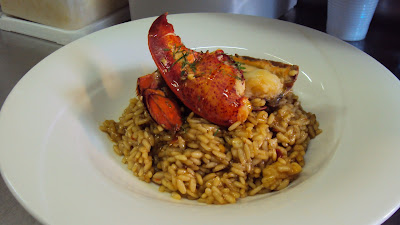We are
already in March and it suddenly occurred to me that we haven´t eaten any calçots.
Last year I flew up from Sevilla specifically to attend a Calçotade (Calçot
binge) in the Catalan hills and was left smittened by the sweet, smokey flavour
of the Calçot de Valls – a cousin of the onion unique to Catalaña.
There seems
only to be one way to cook calçots – at least I haven´t seen another method –
and that is over flames. Calçots looks like a cross between a leek and an onion
and should come in contact with the wood-fire so that the skin burns to black.
They are then wrapped in newspaper to keep warm and maintain their moisture
until finally torn-open, the black skin removed and the juicey white “meat”
eaten with that hanging-over-the-mouth method: an extremely messy and delicious
business.
If you
can´t get hold of calçots – and to be honest I´ve never seen them anywhere
other than Cataluña – then make some Catalan friends and get invited to a
calçotade. Last year was a joy, in the warm early spring sun, lazing in the
beautiful Catalan countryside with beers and friends and the eager company who took
care of everything. Failing that you could try leeks, though I have never done
this and therefore can not vouch for its success.
But I am
digressing slightly as what I really want to share with you is the sauce that traditionally
accompanies calçots – a wonder called Romescu. This sauce, again typically
Catalan, contains all the great ingredients of the Mediterranean; tomatoes,
olive oil, vinegar, toasted almonds, garlic, onions, bread and specifically to
this region, ñoras. Aside from the regality of this ensemble, the ñora really
adds the punch and slightly piquant flavour which marks this out from other
tomato based sauces. Again I am not sure how easy this dried pepper is to get
hold of outside the Iberian peninsula, but having a look around I see there are
some Spanish produce distributors that sell them under the name Spanish dried
peppers.
Almost
everything can be done in the same oven at 180 degrees. 5 tomatoes in the
passata style (on a baking tray with olive oil and salt), 1 large onion in tin
foil, half a head of garlic also in tin foil and 100g of almonds – if not
toasted already – on another baking tray with oil and salt.
Of these 4
ingredients the almonds only need to brown slightly which takes a few minutes.
Next will be the tomatoes which should be cooked through, with blistered skins
and soft to the touch. The onion will take from 30-45 minutes, again until soft
to the touch and the garlic a little less.
Meanwhile
fry a few slices of bread in oil until it has golden well and is crispy. This
will add a bit of body to the sauce.
Once all
these ingredients have drowned themselves in their own juices remove the skins
and place in a blender with a good glug of olive oil, sherry wine vinegar, salt
and pepper (a pinch of sugar too if the tomatoes need it). Blend all the
ingredients together on a low rotation speed to create an emulsion. The sauce
should become thick and the colour of the cliffs around the Costa Brava at
sunset in July. The adjustment to seasoning is crucial here, especially the
quantities of oil and vinegar so I would recommend a gradual adding, blending
and tasting approach to get your preferred result.
The ñoras,
being the stars, are cooked separately in their own VIP section. Remove the
seeds and place in salted boiling water until the skin is soft. What you want
is the meat inside the skin which can be removed either with a spoon or by
pushing the ñoras with a ladling spoon through a fine sieve. I should say that
I have seen people add the entire ñora, skin and all and the results weren´t as
bad as I would have thought, but I do not condone this fragrant laziness.
Add the
dark burgundy meat of the ñoras – the Costa Brava at midday in January – to the
rest of the ingredients and gently mix them together in the blender.
This sauce
can go with practically anything – sandwiches, pastas, potatoes, pretty much whatever
you can think of - A delicious sauce and really one of the great gifts of the
formidable Catalan kitchen. Be it with or without calçots, you can´t substitute
on the ñoras.













